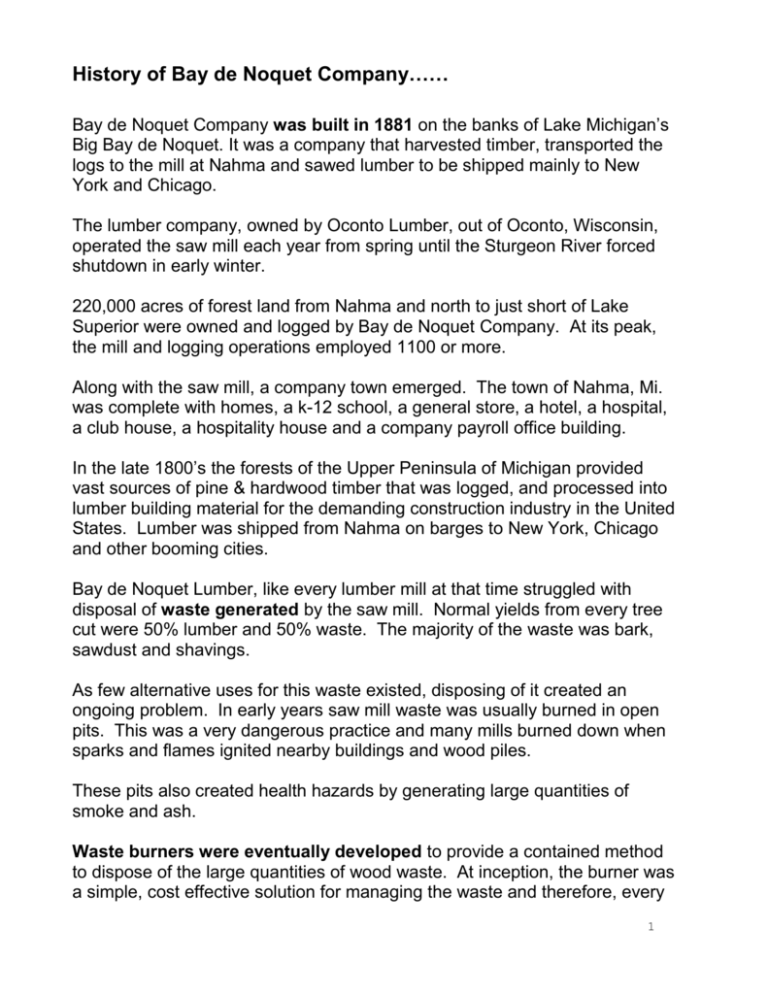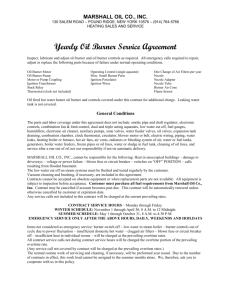Saving the Burner - Nahmatownship.us
advertisement

History of Bay de Noquet Company…… Bay de Noquet Company was built in 1881 on the banks of Lake Michigan’s Big Bay de Noquet. It was a company that harvested timber, transported the logs to the mill at Nahma and sawed lumber to be shipped mainly to New York and Chicago. The lumber company, owned by Oconto Lumber, out of Oconto, Wisconsin, operated the saw mill each year from spring until the Sturgeon River forced shutdown in early winter. 220,000 acres of forest land from Nahma and north to just short of Lake Superior were owned and logged by Bay de Noquet Company. At its peak, the mill and logging operations employed 1100 or more. Along with the saw mill, a company town emerged. The town of Nahma, Mi. was complete with homes, a k-12 school, a general store, a hotel, a hospital, a club house, a hospitality house and a company payroll office building. In the late 1800’s the forests of the Upper Peninsula of Michigan provided vast sources of pine & hardwood timber that was logged, and processed into lumber building material for the demanding construction industry in the United States. Lumber was shipped from Nahma on barges to New York, Chicago and other booming cities. Bay de Noquet Lumber, like every lumber mill at that time struggled with disposal of waste generated by the saw mill. Normal yields from every tree cut were 50% lumber and 50% waste. The majority of the waste was bark, sawdust and shavings. As few alternative uses for this waste existed, disposing of it created an ongoing problem. In early years saw mill waste was usually burned in open pits. This was a very dangerous practice and many mills burned down when sparks and flames ignited nearby buildings and wood piles. These pits also created health hazards by generating large quantities of smoke and ash. Waste burners were eventually developed to provide a contained method to dispose of the large quantities of wood waste. At inception, the burner was a simple, cost effective solution for managing the waste and therefore, every 1 single mill had a waste burner of sorts. These devices were commonly called, silos, truncated cones, or tepee burners depending upon their size and shape. The Bay de Noquet Company waste burner, built in 1899 was of the silo design, measuring 100’ in circumference and rising 125 feet. It was manufactured of steel and brick with its top covered by steel grill and mesh. Conveyors took wood waste from the saw mill directly to the waste burner. The burner provided the necessary method of waste disposal until the lumber company ceased to exist. The saw mill fell silent in July of 1951 with the cutting of the last logs. The town then became the subject of nationwide publicity when Bay de Noquet Company put all its holdings, including the town up for sale. Articles in the October Life Magazine featured this sale. In that fall of 1951 the sale was made to the American Playground Device Company of Anderson, Indiana. In 1959, the American Playground Company sold all its land holdings. The mill was quiet, the forests vast supplies gone, and the town folks concerned about their futures. With everything else becoming a memory, the waste burner continued to stand proudly at the water’s edge. Today the burner has become the only thing remaining of the original saw mill operation and its by-gone era. The Nahma Township Community hopes to preserve Nahma’s Icon to logging by preserving the waste burner as last tangible survivor of the original Bay De Noquet Company sawmill operations. Many years after the fires were extinguished; the burner has continued to serve. At one time K.I. Sawyer Air Force base near Marquette utilized the burner as a land mark for pilots training out of the base. To the recreational fishing members it is the landmark that gets them home safely after a day on the unpredictable waters of Lake Michigan. It marks the channel that leads to the Michigan DNR public access. Most importantly, to the current residents and living descendants of Nahma Township, the waste burner is their link to their past. It represents the blood, sweat and tears of their ancestors, the pioneers of logging in the Upper Peninsula. Years have passed and memories fade and disappear. 2 It is the hope of many of us in various walks of life, however, that the waste burner will continue to stand and that future generations will have the opportunity to visit here and come to understand the historical significance of the burner. Other notes: The first federal patent for a sawmill waste burner design was issued in United States Department of the Interior in 1888 to a Michigan firm, the Muskegon Boiler Works. The Nahma burner exemplified this cylindrical form, with metal plate exterior, thick refractory lining of fire brick that thinned toward the top, and hemispherical wire mesh top. New innovations in sawmill waste burner design took place during the early twentieth century, but Bryant in his 1922 book on Lumber: It’s Manufacture and Distribution (110) references this as still a standard type of waste burner. A review of historic photographs showing sawmill complexes reproduced in a small sampling of published histories of Michigan lumber towns revealed examples of circular-footprint burners similar in appearance to Nahma’s at widely separate towns such as Cadillac, Elk Rapids, Ford River, Grayling, Manistee, Manistique, and Ontonagon and hint at the number that must have existed during the late nineteenth and early twentieth century’s. Locally there was a large burner in Rapid River at the Anderson Lumber Company. 3 Summary of last meeting: On December 18th, 2013 a meeting was called by the Nahma Township Recreation Committee in an effort to pull together interested parties from all over Michigan to work towards “Saving the Nahma Burner”. Approximately 22 people were in attendance to discuss the history of the burner and the importance of the burner to the history of the area and Michigan. The burner built in 1899 is indeed in jeopardy of failure. The 114 year old structure made of steel is rusting and the steel buckling from the weight of the 125 foot tall structure. The cost of repair and improvement will be a task that will require help from many sources. The burner stands as a testament to the hard workers of the logging and sawmill operations in Michigan. It is the last known burner of its type in the Great Lakes and possibly the Northeast United States. It is an Icon that people would like to preserve for future generations to be drawn to for acknowledging an era of workers that labored hard for their company and families. 4 The group determined that an extraordinary effort will need to be fashioned to attain the financial support needed for this protection effort. These are some of the beginning efforts that have gotten underway locally in the last year: A 5 K run is scheduled for June 28th, 2014 prior to the 3rd Annual Nahma Musicfest with all proceeds from the run going to the “Savomg the Burner” project. For more information go to www.nahmatownship.us or contact Tee Lynts, 906-644-2758 The Nahma Township Historical Society has a lifetime membership program with all monies going to saving the burner. This is a one time $100 or more donation giving persons a certificate indicating their effort to saving the burner. There is a Bay de Noquet Clothing Company line of products including tee shirts, sweatshirts and pajama bottoms developed by the Nahma Township Historical Society with all profits going to save the burner. Efforts will be made to seek assistance from the Michigan Tech University Forestry and Industrial Archeology programs for engineering expertise on repair options and cost estimates for the burner. Outreach efforts will be made to get assistance from State governmental and private foundations to receive assistance in the burner effort. The Michigan Humanities members, of whom many were in attendance will be engaged to help with storytelling, music programs and other programing that will bring attention and support to the program. Assistance from the Hannahville Indian Community and the Sault Ste. Marie Tribe of Chippewa Indians will be examined because so many of the people that worked at the Bay de Noquet Company in Nahma were members of these tribes. Efforts are being undertaken to write a book on “Nahma, A Company Town”. Help is needed here and all money generated from this effort will go to “Saving the Burner”. 5 As a result of the meeting an account has been set up to receive funds for “Saving the Burner. The address is: Kathy Fries Treasurer “Save the Burner” Checks payable to “Save the Burner” 14203 Nahma Shores Drive Nahma, MI 49864 There has been one donation of $1000.00 to date coming from Kevin & Joan O’Neil of Chicago. Jenifer Strauss from Story be told Productions donated 200 Storytelling Cd’s: Michigan Legends and Lore: Stories from Shore to Shore to be sold at the Nahma Inn, Christine’s Gallery, Nahma Township Museum, and anywhere else attention can be drawn to raising money for the burner by the Chamber, Tourist Centers etc. (Value of $3000 if all the CD’s sell.) There is a facebook page developed for “Saving the Burner” that will give a background of efforts and keep people appraised of the progress in this effort. It was suggested by Steve Masters that we actually have a Festival called “Burn the Burner”, where the burner would actually be lit! It would draw more people if the burner actually could be made to burn with smoke billowing out. This could be done once or twice per year. “If you burn it, they will come”. Boaters will come, people from all over the country will come. Nowhere else in the USA is there “Burn the Burner Festival”. This could be a huge potential for economic impact for all of Delta County. Flyers, brochures and articles will be developed to make people aware of the need to help this historic Icon. Help from a great variety of resources will be needed to bring this project of “Saving the Nahma Burner” to Fruition. It represents a history of the Upper Peninsula, a story of Michigan and important Icon to the people that shipped the lumber to many areas of the United States. Prepared by Glenn Lamberg, Nahma Township Recreation Coordinator, February 9, 2014 6









